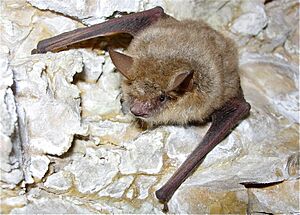Geoffroy's bat facts for kids
Quick facts for kids Geoffroy's bat |
|
|---|---|
 |
|
| Conservation status | |
| Scientific classification | |
| Genus: |
Myotis
|
| Species: |
emarginatus
|
 |
|
Geoffroy's bat, also known as the notch-eared bat, is a type of vesper bat. These interesting bats can be found across parts of Europe, Asia, and Africa. They are known for their unique eating habits and their special ears.
Contents
What Does Geoffroy's Bat Look Like?
Geoffroy's bat is a medium-sized bat. It has long, woolly fur. The fur on its back is usually rust-brown or fox-red. Its belly is a light yellowish-brown color. Young bats are almost completely grey.
Its face is light brown. The ears are brown and have a special notch, or cut, on the outer edge. They also have small, wart-like bumps on the ear flap. The small piece of cartilage in the ear, called the tragus, does not reach this notch. The bat's wings are brown and wide. The edge of its tail membrane has short, soft hairs.
What Do Geoffroy's Bats Eat?
Geoffroy's bats mainly eat spiders and flies. In some areas, like southern Belgium, they mostly eat blood-feeding flies. These include the stable fly and the face fly. These flies can make up a big part of their diet.
They also eat many web-building spiders. When there are not enough flies, spiders become a more important food source. Most spiders they eat are from the family Araneidae. Some are also from the Theridiidae family. Other insects are a smaller part of their diet.
In places like the Southern Basque Country, Geoffroy's bats eat many different arthropods early in the breeding season. Flies are the biggest part of their diet then. As the season goes on, more spiders and flying insects appear. The bats then start to eat more spiders. By August, one type of orb-web spider, Araneus diadematus, can be 80% of their food. The stable fly and the housefly are also important foods there.
These bats prefer to eat prey that cannot fly, like spiders. They also eat flies that do not fly at night. This means they often catch their food by picking it off surfaces or leaves. They have even been found with spiderwebs in their droppings. This suggests they can catch spiders directly from their webs.
Where Do Geoffroy's Bats Live?
Geoffroy's bats often look for food in forests with broad-leaved trees or mixed trees. They do not go into conifer forests as much. They like dense habitats because their favorite prey, web-building spiders, need complex places to build their webs.
In the northwestern parts of their range, they live near rivers and in grasslands. They also visit cattle sheds often. These sheds have many parasitic flies, which are a good food source. In the Mediterranean areas, they can be found in olive plantations.
These bats usually rest underground or in human buildings. They often share their roosts with other bat species, like Rhinolophus bats.
Protecting Geoffroy's Bat
Some groups of Geoffroy's bats rely heavily on blood-feeding flies for food. This makes them vulnerable when people try to control fly populations. Farmers might try to get rid of flies to protect livestock or human health. This can reduce the bats' food supply.
Also, modern cattle sheds often have better ventilation and cleaning. This means fewer flies are present. This reduces how valuable these sheds are for the bats. In other areas, like the Iberian Peninsula, the bats need complex forest habitats. These habitats help many spiders grow, which the bats then eat. Protecting these natural areas is important for their survival.
Distribution
Geoffroy's bat can be found in many countries. These include:
- Afghanistan
- Albania
- Algeria
- Andorra
- Armenia
- Austria
- Azerbaijan
- Belgium
- Bosnia and Herzegovina
- Bulgaria
- Croatia
- Cyprus
- Czech Republic
- France
- Georgia
- Germany
- Greece
- Hungary
- Iran
- Israel
- Italy
- Jordan
- Kazakhstan
- Kyrgyzstan
- Lebanon
- Luxembourg
- Montenegro
- Morocco
- Netherlands
- North Macedonia
- Oman
- Poland
- Portugal
- Romania
- Russian Federation
- San Marino
- Saudi Arabia
- Serbia
- Slovakia
- Slovenia
- Spain
- Switzerland
- Tajikistan
- Tunisia
- Turkey
- Turkmenistan
- Ukraine
- Uzbekistan
In 2012, one of these bats was even found in southern England.
Sources


